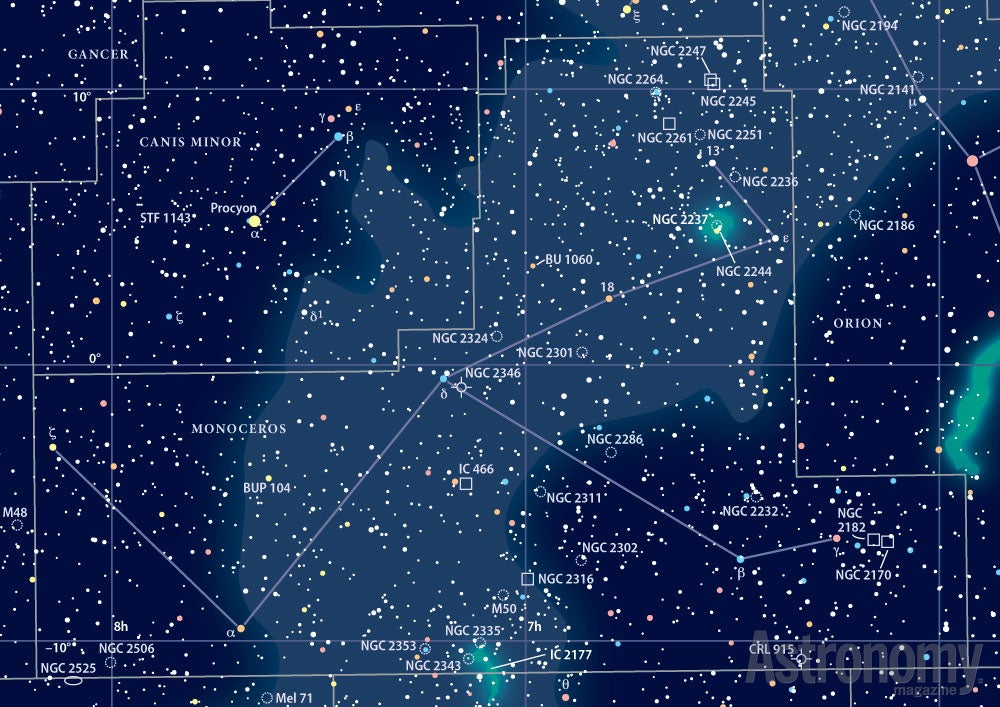Targets for January 29–February 5, 2015
Small telescope:
Avery’s Island (NGC 2353)
Small telescope:
Open cluster NGC 2343
Large telescope:
The Seagull Nebula (IC 2177)
This week’s first small-telescope target is open cluster NGC 2353, also known as Avery’s Island. It lies in the southern part of the constellation Monoceros the Unicorn near Canis Major.
To find NGC 2353, look 6.6 west of magnitude 3.9 Alpha (α) Monocerotis. The cluster shines at magnitude 7.1 and measures 20′ in diameter, which means it covers an area 41 percent as large as the Full Moon.
Through a telescope, the first thing you’ll notice about this target is the magnitude 6.0 non-cluster star SAO 152598, which sits just south of NGC 2353’s center. Next, even a 4-inch scope will reveal three dozen stars in the cluster. Step up to a 12-inch instrument, and you’ll count more than 100 stars. Most shine between magnitudes 9 and 11. Even without the 6th-magnitude luminary, the southern half outshines the northern part.
Astronomy magazine Contributing Editor Stephen James O’Meara named this treasure-trove of stars after Captain Avery, a native of Devonshire, England. In 1695, Avery had captured a ship belonging to the Great Mogul of India. After looting the treasure aboard, Avery retired to an island a rich man.
Small, bright cluster
This week’s second small-scope object is another open cluster in Monoceros, NGC 2343. It lies 1.6° west-southwest of our previous target, or 3.7 east-northeast of magnitude 4.1 Theta (θ) Canis Majoris. Although at magnitude 6.7 it’s brighter than Avery’s Island, it’s quite a bit smaller. NGC 2343 measures only 6′ across.
This object lies within and on the northeastern end of the huge IC 2177 complex, which is our large-telescope target this week.
You can see NGC 2343 easily through binoculars or a finder scope, and sharp-eyed observers have at least an even chance of spotting it from a true dark site. Through a 4-inch telescope, you’ll count 15 stars in a small region. And you may as well stick with a small scope. A 12-inch instrument will add only another 10 stars to the cluster.
Gertrude or Heathcliffe?
This week’s large-telescope target is huge, so it looks best through a telescope/eyepiece combination that gives a wide field of view. It’s an emission nebula in Monoceros called the Seagull Nebula, also known as IC 2177. The Seagull measures 120′ by 40′. That means it covers more area than six Full Moons.
A nebula filter will help a lot when you observe this object. Star chains extend along the length of the nebula. One way to approach it is to disengage an 8-inch or larger telescope’s drive and slowly sweep across the field at low power. You’ll spot the nebula easily.
The detached part of the Seagull Nebula to the south represents the bird’s head. Astronomers designated that object NGC 2327. It measures 19′ by 17′. Near the nebula’s center is an 8th-magnitude star that lies at one end of a thin channel of dark nebulosity. Could that dark division signify the seagull’s mouth? You be the judge.
Lying 1° farther to the south is the reflection nebula Cederblad 90, which glows brightly as it reflects the light of the 8th-magnitude star at its center. Cederblad 90 measures 3′ across and appears round with a hazy edge. Because it’s a reflection nebula, don’t use a nebula filter when you view it.
Through a 12-inch or larger scope, the boundary between IC 2177’s eastern edge and the dark sky appears complex. Also look for several open clusters embedded in the nebulosity, such as NGC 2335 and the aforementioned NGC 2343.
Expand your observing at Astronomy.com
StarDome
Check out Astronomy.com’s interactive StarDome to see an accurate map of your sky. This tool will help you locate this week’s targets.
The Sky this Week
Get a daily digest of celestial events coming soon to a sky near you.
Observing Talk
After you listen to the podcast and try to find the objects, be sure to share your observing experience with us by leaving a comment at the blog or in the Reader Forums.











